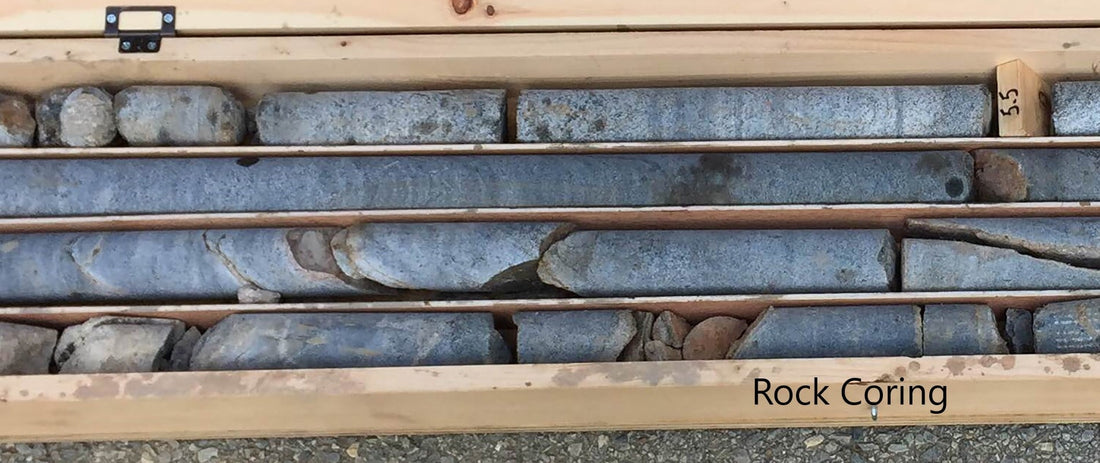Rock Quality Designation, also known as RQD, is an indicator of rock quality. The carrying capacity of foundations strongly depends on the RQD value and recovery core values.
An assessment of the quality of the rock is necessary, particularly when planning pile foundations where very high concentrated loads are applied at one point. Based on the assessment of the condition of the rock, the surface friction and ultimate bearing capacity of the rock are calculated. These calculations are based on tests such as uniaxial compressive strength tests and rock quality parameters such as RQD and core yield.
Furthermore, the rock embedment length depends not only on the applied load but also on the quality of the rock.
The higher the RQD, the higher the quality of the rock. Check out the table below to get an idea of how important it is to know RQD's technical training.
| RQD | Rock quality |
| <25% | Very poor |
| 25 – 50% | poor |
| 51 – 75% | Just |
| 76 – 90% | Good |
| 91 – 100% | Great |
As shown in the table, rock cores with an RQD value of less than 50% are considered inferior rocks. This may be due to fractures in the rock and the quality of the rock tends towards the weathered zone.
RQD in the range of 76-100% can be considered the highest quality rock, most suitable for foundation construction.
Let's look at a sample of rock cores stored in a well investigation .


The figure above clearly shows that the condition of the rock is not uniform. Although it is considered a good quality rock, it presents cracks, discontinuities, weathering, etc.
Therefore, parameters such as RQD and core recovery are important to numerically determine the condition of the rock.
What is RQD?
RQD is defined as the sum of core samples longer than 100 mm divided by the total length considered. The RQD value is calculated as a percentage. Therefore, the above proportion needs to be multiplied by 100.
RQD = (Sum of core parts > 100 mm) / (Total core length) x 100
Let's see how this is calculated in practice.
The following figure shows the details of a sample.


The RQD can be calculated as follows.
RQD = { (38 + 17 + 20 + 43) / (200)} x 100 = 59%
The quality of the rock can be considered adequate as the RQD value of the rock is in the range of 51 to 75%.
Central Recovery (CR)
Core extraction is also an indication of the condition of the rock. If core recovery is less, there is a problem with the rock quality.
If the rock is strong, the CR value should be 100%. However, in practice this may not always be achieved.
There may be fractures, separations, etc. that affect the length of the rock. As shown in the figure above, no cores were recovered at the end of sampling.
Let's see how to calculate CR
CR = {(Total length of recovered rock) / (Total length of core)} x 100
The following figure shows the details of a main sample.


Let's calculate the CR,
The total length of the sample is 1250 mm
CR = {(250 + 200 + 250 + 190 + 60 + 80 + 120) / (1200)} x 100 = 92%
Application of RQD and CR
- Pile foundation : Knowledge of RQD and CR is mandatory Pile foundation design . They provide a clear indication of the condition of the rock that must be removed to drive the piles. Furthermore, geotechnical design parameters reflecting RQD and CR are taken into consideration in pile design.
- Tunnel design : When tunnels are constructed in rock and are to be lined with concrete, the condition of the rock is important in determining the load to be considered for the tunnel lining. Even for an unlined tunnel, knowing the quality of the rock provides an indication of whether it will remain stable after excavation or whether it will require support during construction. Furthermore, for weak rocks where injections are performed to stabilize the rock, these parameters can be used to predict the required duration of injection and the required amount of injection.
- Rock Anchoring : Ties are designed to stabilize the gravitational structure, support the structure, prevent buoyancy, etc. Depending on the design load and the nature of the rock, the ties are further mobilized along the entire length of the rod (12 m) after allowing anchoring into the structure. If there are cracks or cavities in the rock, the mortar injected into the holes will not remain in the hole. This may reduce the load capacity. Furthermore, cracks in the rock also reduce the load-bearing capacity.
- Dam design : Dams are built to retain water. Movement of water across the centerline of the dam must be avoided. In other words, water penetration through the body and foundation of the dam must be minimized. Dam foundations are usually built from solid rock. Rock is not an impermeable material. There are cracks, voids, weathered areas, weak areas, etc. This information can be obtained through borehole investigation. Parameters like core recovery provide a clear understanding of the condition of the rock and are an indication for deciding the extent of grouting etc. Furthermore, RQD can be used as an indication to decide rock quality.

